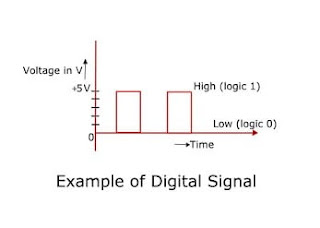The fundamental difference between analog and digital circuits is the type of inputs these circuits take in and the type of output signals these circuits operate on to generate the final output.
Analog circuits operate or work with continuous-valued signals or continuously varying signals, and these signals are commonly referred to as analog signals. Example of an analog signal is sound, light, etc.
Analog signal Example
Digital circuits operate or work on signals whose values exist at two levels only or have only two values, i.e., 0’s (zeros) and 1’s (ones) similar to the Binary number system. These signals are commonly referred to as digital signals. At any given instant, the value of a digital signal can be either high (1) or low(0).
Digital Signal Example
Analog circuits are difficult to design and manufacture since most of the design and manufacturing processes involved are manual. In addition to this, employing automation techniques for designing these analog circuits fail to do the job efficiently.
On the other hand, digital circuits are easy to design since Circuit designers can apply automation techniques at various circuit design levels. This involves minimum human interaction.
Analog circuits can process the input analog signal directly using the analog electronic components and produce an output signal. No conversion of input signals is required before processing, i.e., the input signal is analog. An analog circuit directly performs various logical operations and produces an analog output that humans can easily understand.
In digital circuits, the input signals are converted from analog to digital form before it is processed, i.e., the digital circuit is capable of processing digital signals only and produces an output which is again converted back from digital to analog signals so that the output gives meaning full results that humans can understand.
In analog circuits, since there are no conversions involved at the input or the output side, there is no loss of information available for processing.
Due to the conversion process at the input side(analog to digital) and the output side (digital to analog), some information is lost during the conversion process.
The human resources available to design analog circuits are meager. This results in a long time to market for the finished products.
Analog circuits are mostly custom made and lacks flexibility.
Digital circuits have high degree of flexibility.
Analog Circuits vs Digital Circuits
| Analog Circuits | Digital Circuits |
| These circuits operate on continuous valued signals(commonly referred to as analog signals). | These circuits operate on signals that exist only at two levels i.e. 0’s and 1’s (binary number system). |
| Analog circuits are difficult to design since each component has to be placed by hand as automation techniques for designing these circuits fail to do the job efficiently. | On the other hand digital circuits are easy to design since automation technique can be applied at various levels of circuit design. This involves minimum human interaction. |
| No conversion of input signals are required before processing i.e. input signal is analog, the circuit directly performs various logical operations and produces an analog output. | In digital circuits, the input signals are converted from analog to digital form before it is processed, i.e. the digital circuit is capable of processing digital signals only, and produces output which is again converted back from digital to analog signals so that the output gives meaning full results that can be understood by humans. |
| In analog circuits, since there are no conversions involved at the input or at the output side there is no loss of information that is available for processing. | Due to the conversion process at the input side(analog to digital) and at the output side, some amount of information is lost during the conversion process. |
| The man power available to design analog circuits is very low, this results in long time to market the finished products. | The available man power to design digital circuits is significantly large compared to that of analog circuit designers. |
| Analog circuits are mostly custom made and lacks flexibility. | Digital circuits have high degree of flexibility. |
Note: Even though digital electronics have taken over analog electronics, We still cannot eliminate analog electronics because, in the real world, we use only analog signals, i.e., humans can understand only analog signals (not 0’s and 1’s).
Can you imagine talking to your friend in terms of 0’s and 1’s (sounds funny)?
With all the digital circuits designed to interact with the real world, the digital circuits must have an analog interface.
A simple example would be your computer keyboard.
Each time you type something on the keyboard, you see the corresponding key on the monitor. What happens under your keyboard is: As soon as you type a key, a set of 0’s and 1’s are sent to the processing unit, which is in turn given to the monitor which can understand only 0’s and 1’s the monitor then displays the set of 0’s and 1’s in the form you can understand (English).


